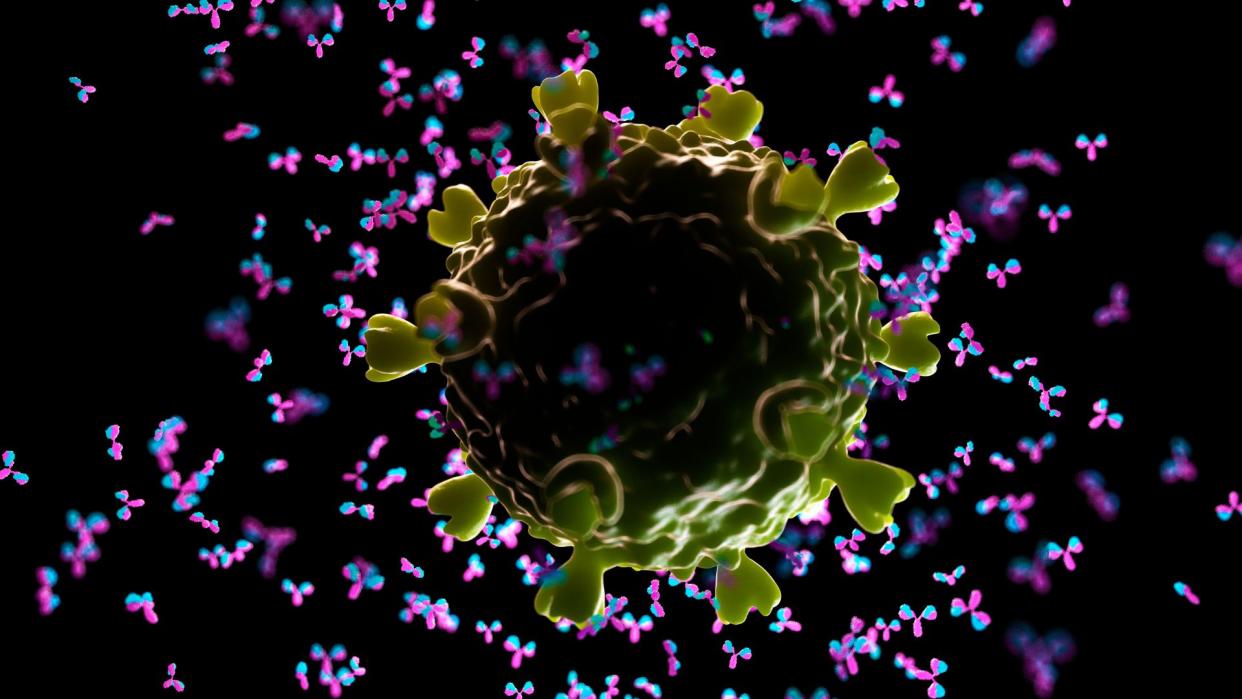In a 1st, HIV vaccine triggers rare and elusive antibodies in human patients

An HIV vaccine is one step closer to reality following a human trial that produced rare and elusive antibodies, a new study reports.
Many hurdles stand in the way of an effective HIV vaccine. The virus is a master of evasion, dodging the immune system by coating itself in sugars that resemble those made by the body, said Dr. Barton Haynes, a leader of the recent trial and director of the Duke Human Vaccine Institute. The virus also mutates rapidly, changing its form so that the immune system struggles to make antibodies that can grab hold of it.
A major goal in HIV vaccine development is triggering the production of broadly neutralizing antibodies, which latch onto parts of the virus's outer coating, or envelope, that are very similar between different HIV strains. This makes the antibodies protective against a wide variety of strains, regardless of how they mutate.
The challenge is that "these antibodies, naturally during infection, are very rare to find," said Thomas Hope, a professor of cell and developmental biology who studies HIV at Northwestern University Feinberg School of Medicine. "It takes a couple years of real infection to make these antibodies," said Hope, who was not involved in the new study but has collaborated with some of its authors in the past.
Related: We could end the AIDS epidemic in less than a decade. Here's how.
Vaccines typically work by eliciting a similar immune reaction to what's seen during a real infection. But in the case of HIV, vaccine developers have to dramatically expedite the process, calling forth antibodies in weeks that would usually take years to show up.
Now, in a study published Friday (May 17) in the journal Cell, scientists have demonstrated that this feat is possible in humans.
"We're gathering proof of concept that a vaccine could be made — can be made," Haynes told Live Science. "We're having to coax the immune system, to guide the immune system in a way we've never had to do."
In the trial, the researchers targeted a protein embedded in HIV's envelope — specifically, part of the protein called the membrane proximal external region (MPER). The coveted antibodies that target MPER bind to both the backbone of this protein and to the fatty membrane it's embedded within.
"These are very unusual because they bind two things at once," Haynes said, and this makes the antibodies oddly shaped. To make antibodies of the right shape, immune cells must pick up genetic mutations over time, following exposure to a pathogen. But for reasons not fully understood, the mutations required to make antibodies against MPER and similar targets happen only very rarely.
The idea behind the new vaccine is to make these mutations more probable by exposing the immune system to a series of reaction-triggering substances. These substances, or immunogens, contain short snippets of protein and bubbles of fat. "What we're learning to do is design immunogens that can select for these rare mutations very efficiently," Haynes said.
This strategy has been demonstrated in various animal models and early human studies that aimed for targets other than MPER. These previous studies successfully coaxed immune cells to make precursors to the final, desired antibodies — but the new trial represents the first time that the end-goal antibodies have been achieved in people.
"This supports the whole concept," Hope told Live Science. "Many worry if this is possible," so the new study lends credence to this iterative HIV vaccination strategy.
RELATED STORIES
—How are people cured of HIV? Here's everything you need to know
—Kids under 5 with HIV are dying at high rates. Here's why.
The trial included 20 HIV-negative volunteers. Fifteen received two vaccine doses, spaced two months apart, while the remaining five got a third dose four months after their second. Tests showed that two doses of vaccine triggered a robust response from immune cells and kicked off the production of broadly neutralizing antibodies. The team further confirmed the presence of these antibodies in the three-dose group by closely analyzing their immune cells.
The original goal of the trial was for everyone to get four doses, but it was paused after one participant given three doses had a serious allergic reaction to a vaccine ingredient called polyethylene glycol (PEG). PEG helps to stabilize certain types of vaccines in the body, but rarely, patients can have a reaction to it. The researchers have now reformulated the vaccine without PEG and will soon test the new version.
This is just one step toward making an effective HIV vaccine, Haynes emphasized. The ideal vaccine would induce four different types of broadly neutralizing antibodies — that is, anti-MPER antibodies plus three more kinds. This would help prevent HIV from escaping the vaccine's protection. In addition, the antibodies need to be made in high quantities and hang around in the body for a long time.
"It's a decent starting point and it can be built upon and combined with other people's work," Hope said of the recent trial. He added that he hopes this vaccine strategy pans out, given the potential it has shown so far. Hope has been studying HIV since the late 1980s.
"I would really like to see the end of this virus," he said. "It'll lose eventually, but I'd like to see it losing."
Ever wonder why some people build muscle more easily than others or why freckles come out in the sun? Send us your questions about how the human body works to community@livescience.com with the subject line "Health Desk Q," and you may see your question answered on the website!

